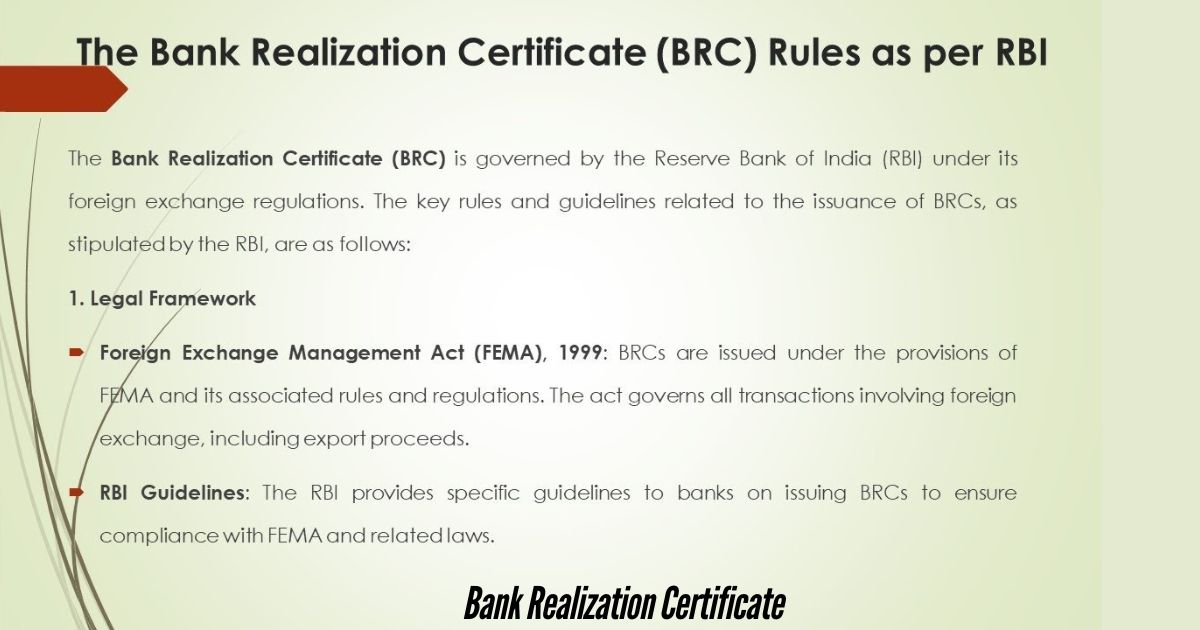A Bank Realization Certificate (BRC) is a vital document for businesses engaged in international trade. It serves as proof that the payment for goods or services exported has been received by the exporter. This document is issued by a bank after confirming that the exporter’s payment has been successfully credited to their account. In this article, we will explore the significance of BRC, its issuance process, and how it benefits exporters.
What is a Bank Realization Certificate (BRC)?
A bank realization certificate is an official certificate provided by a bank confirming that the foreign currency received from the buyer has been credited to the exporter’s account. This certificate is usually issued when the exporter’s payment for exported goods or services is successfully realized.
In countries like India, the BRC is an essential document for the Export Promotion Council (EPC) and other regulatory authorities to verify whether the payment for exports has been received. It helps maintain transparency and ensures that the transactions comply with international trade regulations.
The Importance of BRC in International Trade
- Proof of Payment Received: The BRC acts as evidence that the exporter has received payment for the goods or services provided. This is crucial for fulfilling contractual obligations between the exporter and the buyer.
- Facilitates export incentives: In many countries, businesses can claim export-related benefits or incentives, such as tax exemptions or subsidies. A valid BRC is often required to avail of these benefits, as it serves as proof of export and payment receipt.
- Ensures Compliance: A Bank Realization Certificate ensures that the foreign currency has been realized and deposited into the exporter’s account, which is necessary for compliance with foreign exchange regulations.
- Simplifies Audits: The BRC is an important document for auditors and tax authorities. It helps them confirm that the export transactions were legitimate and that the foreign exchange received was properly accounted for.
How is a bank realization certificate issued?
The process of obtaining a BRC typically involves the following steps:
- Completion of Export Transaction: The exporter ships goods or provides services to the foreign buyer. Upon receiving the payment for the exported goods, the exporter’s bank is notified.
- Bank Receives Payment: The bank receiving the payment (often a foreign bank or the exporter’s bank) credits the payment into the exporter’s account.
- Request for BRC: The exporter then submits a request to the bank for a Bank Realization Certificate. This request is often made along with the necessary export documentation, such as the export invoice, shipping documents, and payment details.
- Verification by the Bank: The bank verifies the export transaction, ensuring that the payment has been credited correctly and meets the criteria for a BRC.
- Issuance of the Certificate: After verification, the bank issues the BRC to the exporter. The certificate includes details such as the exporter’s name, the amount received, the date of payment realization, and other relevant information.
Key Details Included in a Bank Realization Certificate
A bank realization certificate typically includes the following information:
- Exporter’s Name and Address
- Bank’s Name and Branch
- Details of the Export Transaction (Invoice number, export date, etc.)
- Amount Realized (in foreign currency and local currency)
- Date of Payment Realization
- Mode of Payment (e.g., bank transfer, draft, etc.)
- Foreign Exchange Code (FEC), if applicable
Benefits of a Bank Realization Certificate
- Trade Compliance: A BRC ensures that your business complies with international trade regulations, especially regarding foreign exchange management and reporting.
- Access to Export Incentives: Exporters can access various government incentives and schemes by submitting a valid BRC. This document proves that payment has been received and helps in claiming benefits.
- Credibility: The issuance of a BRC builds trust and credibility between the exporter and regulatory bodies, customers, and banks, proving that payments are made as agreed.
- Enhanced Transparency: It adds a layer of transparency to the export process by documenting that the export transaction was completed successfully and the payment was received as per the terms.
Challenges and Considerations
While a Bank Realization Certificate is an essential document for exporters, there are a few challenges that businesses may face:
- Delays in Issuance: Sometimes, there may be delays in the issuance of the BRC due to verification issues or discrepancies in the payment details. It is important to ensure that all required documentation is accurate and submitted in a timely manner.
- Currency Conversion: In the case of currency conversion, the exporter may face discrepancies between the foreign exchange rate applied by the bank and the market rate. This can impact the amount realized in the local currency.
- Understanding the Legal Framework: Exporters must ensure they understand the legal framework surrounding the BRC, especially if they are dealing with multiple countries with different regulatory requirements.
Conclusion
The Bank Realization Certificate (BRC) is an indispensable tool for exporters, helping them manage foreign exchange transactions efficiently and ensuring that their export activities are fully compliant with international trade regulations. By obtaining a BRC, businesses can also unlock various government benefits, increase their credibility, and maintain smooth operations in global markets.
As the world of international trade becomes increasingly complex, understanding the importance of documents like the BRC will empower businesses to navigate the process with greater confidence and ensure long-term success in the global marketplace.
This article provides a detailed overview of the Bank Realization Certificate, its significance, process, and benefits for exporters. Let me know if you’d like to add or adjust anything!
